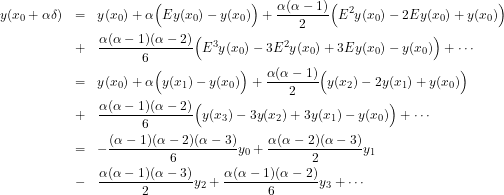Suppose that you have a table or array of the values of a function

One can perform a linear interpolation\ to obtain ![]() for
for
![]() by assuming that the curve is well approximated by a straight line between adjacent points listed in the table
by assuming that the curve is well approximated by a straight line between adjacent points listed in the table
![]()
If the points ![]() are evenly spaced with
are evenly spaced with ![]() , the Lagrange interpolation can provide better accuracy. Notice that
, the Lagrange interpolation can provide better accuracy. Notice that
![]()
in which ![]() is the shift operator
is the shift operator
![]()
Then
(1) 
which we can expand as
(2) 
Collect terms together and use the fact that
![]()
then
(3) 
and so on, here correct to third order differences. Notice that if ![]() , for
, for ![]() , we simply obtain
, we simply obtain ![]() . One would use this to get
. One would use this to get ![]() for
for ![]() in practice, given a set of
in practice, given a set of ![]() -values for regularly-spaced
-values for regularly-spaced ![]() -values, giving a significant improvement over linear interpolation. It can be used to develop predict-correct numerical integration algorithms (which is why we are interested in it). For example consider a function
-values, giving a significant improvement over linear interpolation. It can be used to develop predict-correct numerical integration algorithms (which is why we are interested in it). For example consider a function ![]() and its derivative
and its derivative ![]() , and apply this to the case
, and apply this to the case ![]() and
and ![]() instead of
instead of ![]() , we obtain
, we obtain
![]()
Now consider numerically integrating ![]() from
from ![]() to
to ![]() by Simpson’s rule
by Simpson’s rule
![]()
and into this insert the previous interpolation formula to eliminate ![]() on the right side to obtain the interpolation
on the right side to obtain the interpolation
![]()
Bashford-Adams-Milne integration is a predict-correct method based on the interpolation formula that we just derived. Consider a differential\equation
![]()
and make a guess solution ![]() that satisfies the boundary conditions (say
that satisfies the boundary conditions (say ![]() ) and build up a table from the guess solution. From the derivatives of the guess solution make the predictions
) and build up a table from the guess solution. From the derivatives of the guess solution make the predictions
![]()
then compute from these new values of the derivatives from
![]()
and then correct the prediction using Simpson’s rule
![]()
We simply iterate the procedure until desired accuracy is achieved. This method does not suffer from the accumulated errors of Euler. Here is an example in REDUCE for the equation
![]()
on rounded;
operator x,y,yp;
delta:=0.01;
for n:=0:100 do x(n):=n*delta;
% remember y'=!F
!F:=1.0+!Y^2;
y(0):=0.0;
% First guess
for n:=1:100 do y(n):=x(n);
for n:=0:100 do yp(n):=1.0;
% Predictor
% Iterate predict/correct cycle
for m:=0:10 do <<
for n:=4:100 do y(n):=y(n-4)+(8.0*delta/3.0)*(yp(n-3)-0.5*yp(n-2)+yp(n-1));
% Recompute y'
for n:=0:100 do yp(n):=sub(!Y=y(n), !F);
% Correct (note we DON't mess with y(0))
for n:=2:100 do y(n):=y(n-2)+(delta/3.0)*(yp(n-2)+4.0*yp(n-1)+yp(n)) >>;
% compare to exact solution
for n:=0:100 do write y(n), " ", tan(x(n));Note that ten cycles gives excellent accuracy (![]() versus
versus ![]() ).
).